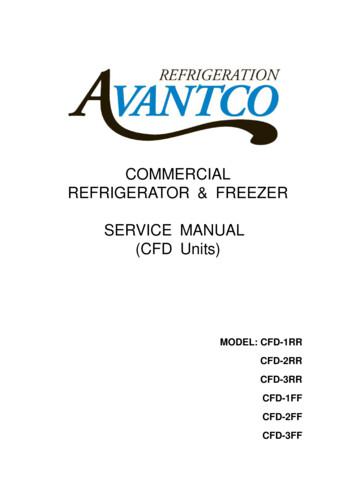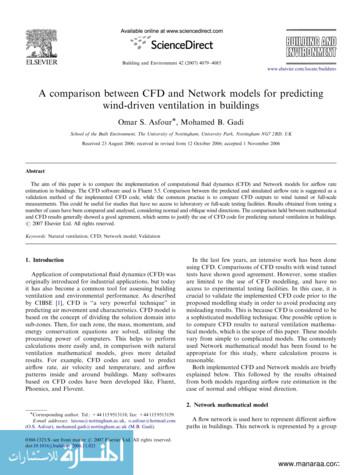Comparison Of Two CFD Tools Against Measurements On Complex . - ForWind
Comparison of two CFD tools againstmeasurements on complex terrain1st Symposium OpenFOAM dedicated to Wind Energy – March 21st 2013Benoit Bichet, Tristan Fabre, Philippe Alexandre
CONTEXT 1st independent validation case for newly introduced OpenFOAM-based WRAsoftware ZephyTOOLS developped by Zephy-Science , GPL licenced Software under development Objectives Site conditions and Wind Resource Grids (WRG) comparison with twoCFD models: ZephyTOOLS and Meteodyn Mean wind speed and turbulence intensity: validation againstmeasurements Drawbacks Lack of time for a better visualization of the results
SUMMARY La Compagnie du Vent - overview Site description and validation process Numerical models description Results Models behaviour Visualization Comparison against measurements Resource grids Perspectives and Conclusion
La Compagnie du VentSite description and validation processNumerical models descriptionResultsLa Compagnie du Vent in figures Creation Date: 1989 French pioneer - 1st WT installed in 1991 Share Capital: M 14 Staff: 150 people Installed wind turbine output: 300 MW (in France and Morocco) Operating wind farms: 23 since 1993 Future solar output (currently under construction): 70 MW Use of CFD for complex terrain ̴ 2005
La Compagnie du VentSite description and validation processNumerical models descriptionResultsSITE DESCRIPTION Complex terrain – Southern FranceROQUETAILLADE 3 measurement masts (RoqI, RoqII, Preproj)(1996 - now) 28 turbines 22.9 MW Mean wind speed 7 m/s at 44m E-W dominant winds290 110 La Compagnie du Vent / David Richard
La Compagnie du VentSite description and validation processNumerical models descriptionResultsOrography and roughness maps Hilly terrainSignificant roughness surrounding the wind farmLow roughness on the plateau itself
La Compagnie du VentSite description and validation processNumerical models descriptionResultsVALIDATION PROCESS Complex terrain for CFD relevance Comparison Meteodyn/ZephyTOOLS: similar methodology, different modeling Validation against measurements Strong winds events to meet the model methodologiesResults independent of wind speeds(Neutral thermal stratification considered)3rd direction / 310 Main direction / 290 Tool’s Performances Accuracy vs. measurements physical representativeness vs. Meteodyn Calculation time and convergence rates2nd direction / 110
La Compagnie du VentSite description and validation processNumerical models descriptionResultsNUMERICAL MODELS DESCRIPTIONPhysical modelsMeteodynZephyTOOLSSolverCoupled solutionSegregated solution using a SIMPLE approachFlow modelSteady-state, incompressible, isothermSteady-state, incompressible, isothermTurbulence modelingRANS 1-equation closure schemeRANS 2-equations closure schemeInflowOwn designBased on atmBoundaryLayerInlet for evaluating the ABLinflow charateristicsLand cover modelingWall ground boundary conditions forest Wall ground boundary conditionscanopy modelnutkAtmRoughWallFunctionInitializationDeduced from modelized ABL conditionsPrecalculation on coarse grid, remapping as initialconditions in final gridConvergenceNo specific controlCalculation results monitoring at key points, user controlpossibleMinimal Horizontal Resolution: 20mMinimal Vertical Resolution: 4mFrom 3.2 millions to 5.6 millionsN of elements in z-direction: 32Minimal Vertical Resolution: 2m6 millions of cells for the primary directions : MESH1- 33m horizontal resolution2 millions of cells for other directions smoothing towardsflat terrain near side boundary conditions: MESH2- 63m horizontal resolutionN elements in z-direction: 52Meshing
La Compagnie du VentSite description and validation processNumerical models descriptionResultsPrimary directions - MESH1InitializationCalculationSecondary directions - MESH2
La Compagnie du VentSite description and validation processNumerical models descriptionResults
La Compagnie du VentSite description and validation processNumerical models descriptionResultsRESULTS – Summary Directional results (straight outputs) for the 3 main directions Visualizations of directionnal results: superimposition with terrain mapping Flow inclinationSpeed-up factorsComparison with measurements for the main direction Flow inclinationDirectionTurbulence intensitySpeed-up factorsHorizontal wind speedsTurbulence intensityWind resource grids at hub height using Openwind
LegendRESULTS – models behaviour – 3 main directionsMast 1 - RoqIMast 2 - RoqIIMast 3 - PreprojFlow inclinationDirectionTurb. intensityHor. speed-up factorsVery similar ( 1 )Very similar ( 1 )Big (!)Variable (!)110 290 310
La Compagnie du VentSite description and validation processNumerical models descriptionResultsRESULTS – superimposed visualizations290 -Flow inclinationMeteodynZephyTOOLS
La Compagnie du VentSite description and validation processNumerical models descriptionResultsRESULTS – superimposed visualizations110 -Speed-up factorsMeteodynZephyTOOLS
La Compagnie du VentSite description and validation processNumerical models descriptionResultsRESULTS – comparison with measurements 290 / main direction / horizontal wind speedMast 2 - RoqIIMast 1 - RoqI
La Compagnie du VentSite description and validation processNumerical models descriptionResults 290 / main direction / turbulence intensityCaution! . Meteodyn uses a forest model likely responsible for the over-estimations. Meteodyn requires turbulence correction matrixes at the ‘synthesis’ step (takinginto account the measurements) to correct potential over/under-estimations. ZephyTOOLS does not enable – yet – the ‘synthesis’ step and therefore a straightcomparison is not relevant (interesting though for orders of magnitude)Mast 2 - RoqIIMast 1 - RoqI
La Compagnie du VentSite description and validation processNumerical models descriptionResultsRESULTS – mappings comparison at hub heightMeteodynZephyTOOLS
CONCLUSIONS Good first impression A majority of similar results with the 2 models Major differences in turbulence(however explainable) Calculation time 4*greater with ZT! But convergence control confidencePERSPECTIVES Comparisons at higher hub heights Plot {ZephyTOOLS – Meteodyn} mappingsfor a better visualization of the differences Plot turbulence vs. roughness for the forest modeling’s impact in Meteodyn Correct the turbulences cf. slide 16 Open source - new features evolving with continuous feedback!
Thank you for your attention!ZephyTOOLS is a registered trademark of Zephy-Science
Comparison of two CFD tools against measurements on complex terrain 1st Symposium OpenFOAM dedicated to Wind Energy - March 21st 2013 Benoit Bichet, Tristan Fabre, Philippe Alexandre . Site conditions and Wind Resource Grids (WRG) comparison with two CFD models: ZephyTOOLS and Meteodyn Mean wind speed and turbulence intensity .
refrigerator & freezer . service manual (cfd units) model: cfd-1rr . cfd-2rr . cfd-3rr . cfd-1ff . cfd-2ff . cfd-3ff . 1 table of contents
The CFD software used i s Fluent 5.5. Comparison between the predicted and simulated airflow rate is suggested as a validation method of the implemented CFD code, while the common practice is to compare CFD outputs to wind tunnel or full-scale . Both implemented CFD and Network models are briefly explained below. This followed by the .
430 allocation to elianto cfd o&m 20,577.32 440 allocation to trillium west cfd o&m 27,267.00 450 allocation to west park cfd o&m 70,008.22 460 allocation to festival ranch cfd o&m 177,790.54 480 allocation to tartesso west cfd o&m 27,809.17 481 allocation to anthem sun valley cfd o&
Emphasis is on comparing CFD results, not comparison to experiment CFD Solvers: BCFD, CFD , GGNS Grids: JAXA (D), ANSA (E), VGRID (C) Turbulence Models: Spalart-Allmaras (SA), SA-QCR, SA-RC-QCR Principal results: Different CFD codes on same/similar meshes with same turbulence model generate similar results
The first objective is to make comparison between the three CFD software which consists of ANSYS Fluent, Star-CCM and IESVE Mcroflo according to CFD . In terms of simulation results from the three baseline models, ANSYS Fluent is conclusively recommended for CFD modeling of complicated indoor fluid environment compared with Star-CCM
Trindade, B.C. and J. Vasconcelos. 2011. "Comparison of CFD with Reservoir Routing Model Predictions for Stormwater Ponds." Journal of Water Management Modeling R241-05. doi: 10.14796/JWMM.R241-05. . This may help to explain why such CFD models are seldom used for detention pond analysis. Comparative Study of a CFD Model and a Reservoir .
an opportunity to use Computational Fluid Dynamics (CFD) to supplement experimental data with . and flow across the physics of interest. In order for CFD to be used confidently, these models must be validated against expected literature correlations as well as experimental data. . Wall Nusselt Number Comparison for CFD and Experimental .
Artificial Intelligence: what consumers say Findings and policy recommendations of a multi-country survey on AI. 02 Products and services consumers deal with on a daily basis – e.g. insurance policies based on automated risk assessments, pro - duct offers on e-commerce sites and price comparison tools – are increasingly powered by artificial intelligence (AI). This technology promises to .























